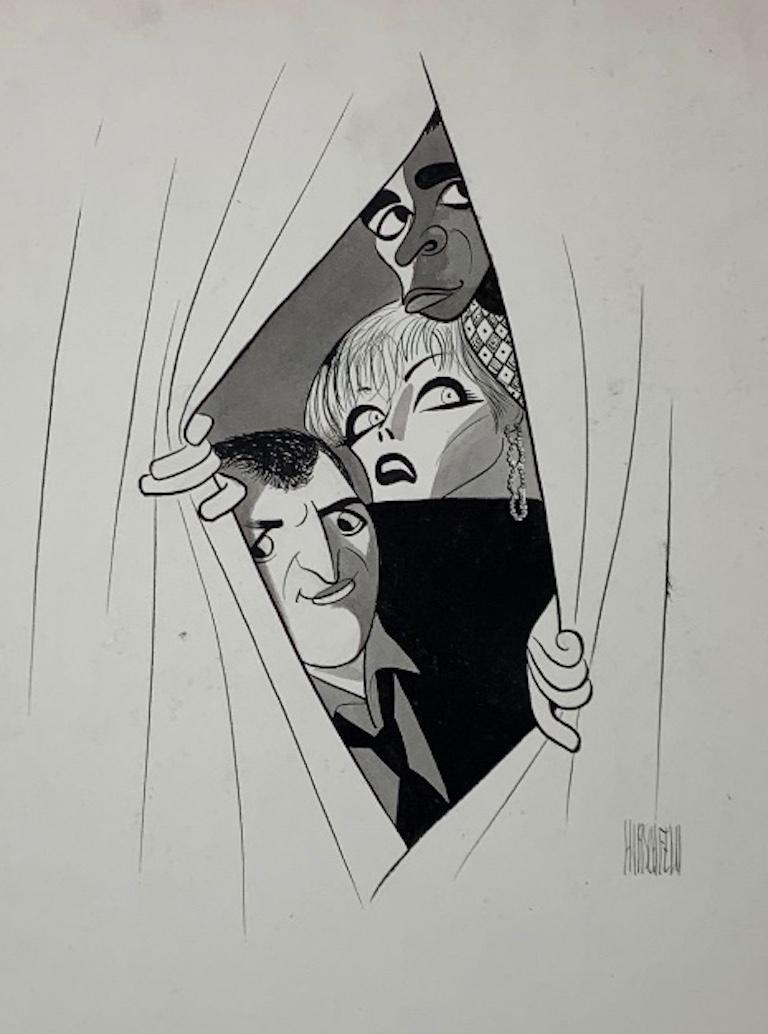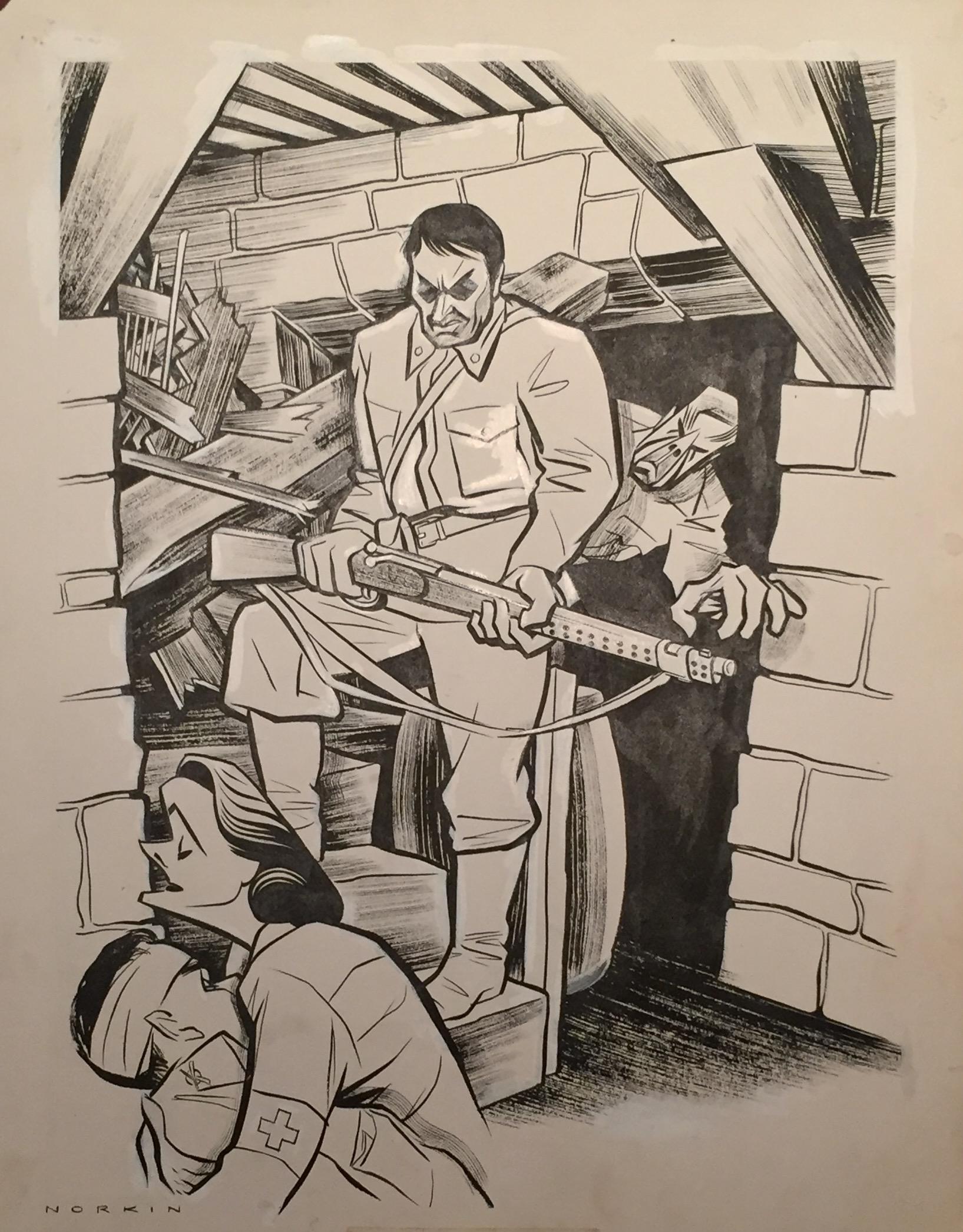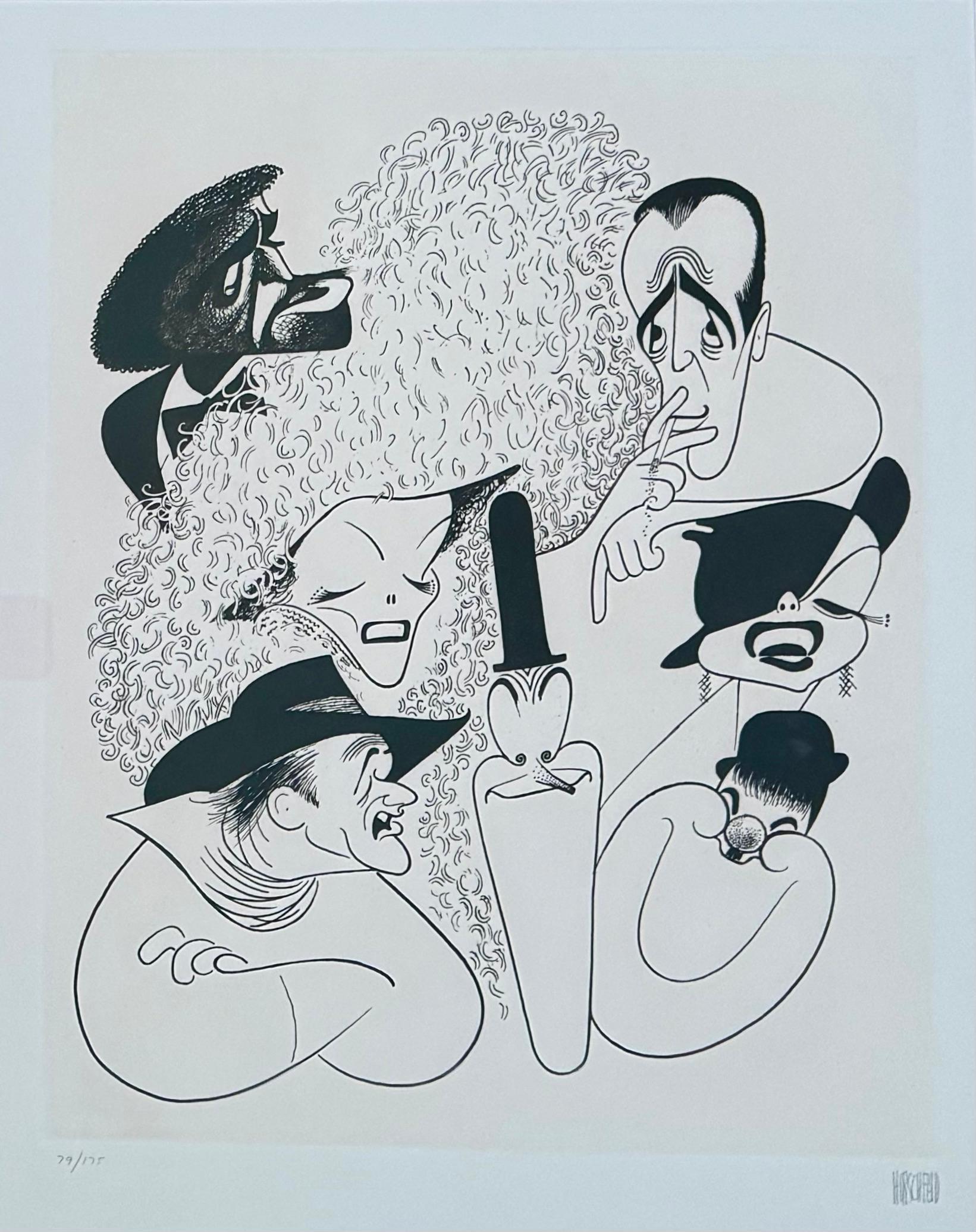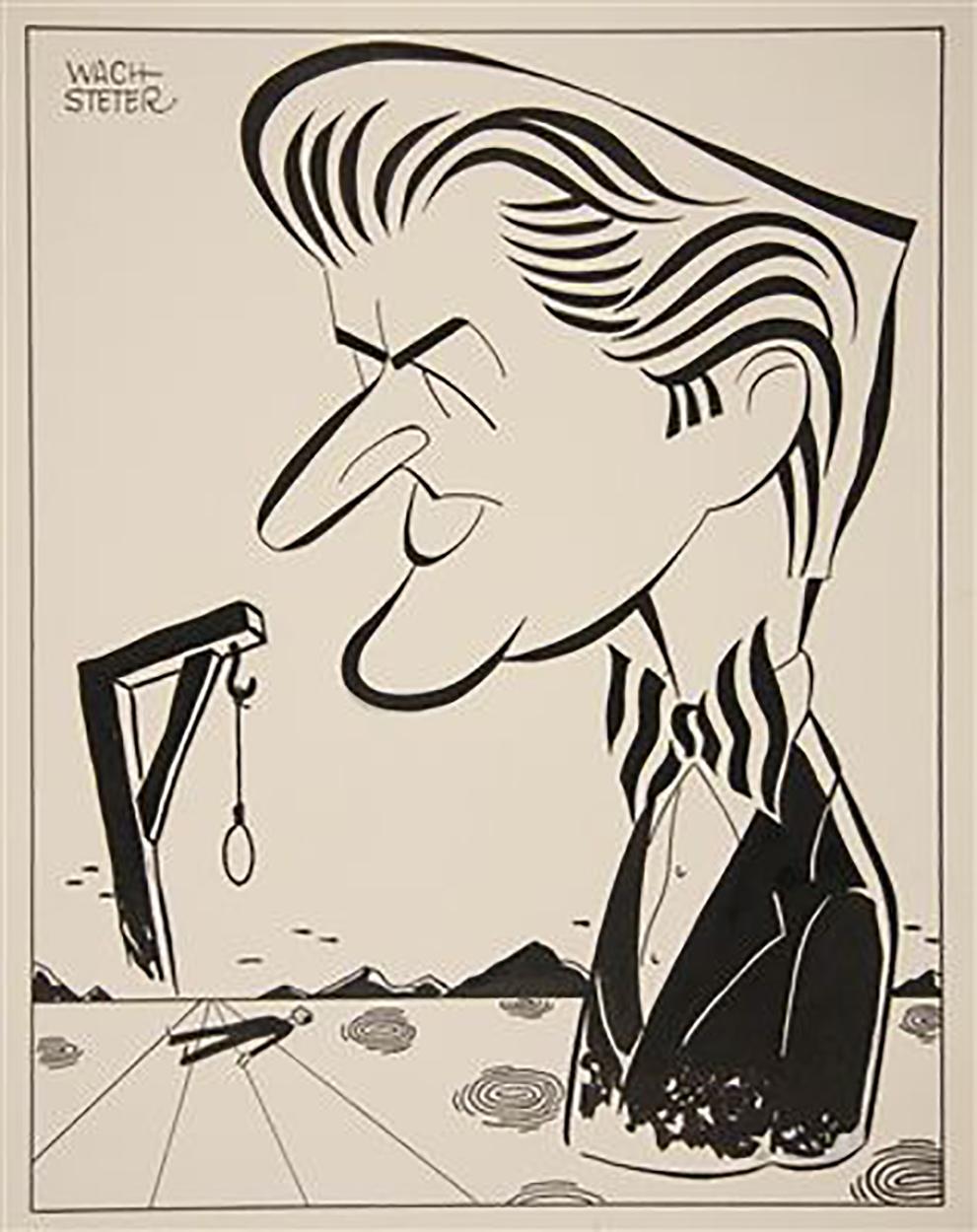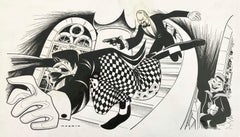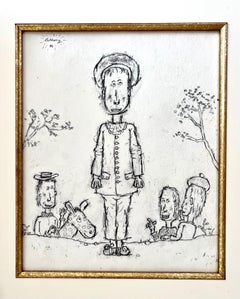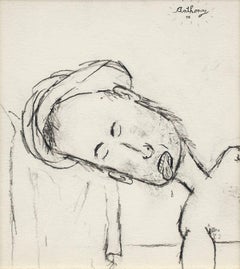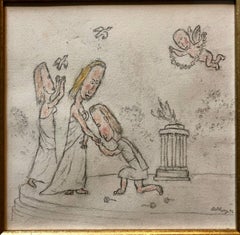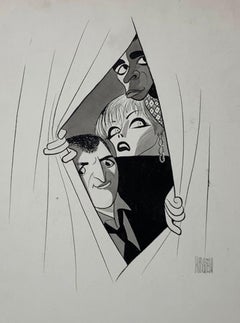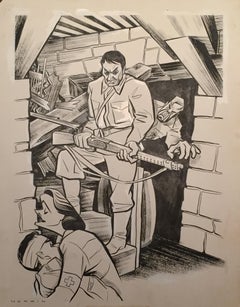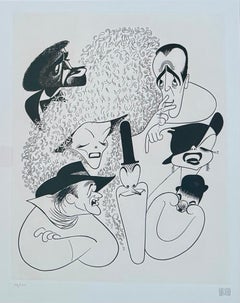Items Similar to "Stand up Tragedy" Marcus Chong Original Ink Drawing Theater Caricature Art
Want more images or videos?
Request additional images or videos from the seller
1 of 9
Sam Norkin "Stand up Tragedy" Marcus Chong Original Ink Drawing Theater Caricature Art
$650
£494.22
€569.35
CA$924.13
A$1,004.37
CHF 530.77
MX$12,150.70
NOK 6,610.36
SEK 6,243.90
DKK 4,250.84
About the Item
"Stand up Tragedy" - Jack Coleman, Marcus Chong & Charles Cioffi
Samuel Norkin (January 10, 1917 – July 30, 2011) was a Brooklyn, New York-born cartoonist who specialized in theater caricatures, Illustration Art, for more than seven decades. His drawings of theater, opera, ballet and film celebrities appeared in Variety, Backstage, The Philadelphia Inquirer, The Washington Post, Los Angeles Times, The Boston Globe and many other publications.
Norkin learned composition and anatomy from the muralist Mordi Gassner. He received a scholarship to the Metropolitan Art School after his high school graduation, and he later attended Cooper Union, the Brooklyn Museum Art School and the School of Fine and Industrial Art. During the 1940s, newspaper editors wanted to devote more space to new theatrical productions, but photo opportunities usually did not happen until a show opened. Norkin took advantage of the situation and gained access to rehearsals, performers, costume sketches, fittings and scenic designs, providing editors with illustrations prior to an opening.
From 1940 to 1956, his theatrical illustrations were a regular feature in the New York Herald Tribune. Then for the next 26 years, he covered the performing arts for the Daily News. Since 1940, Norkin has had more than 4000 drawings published.
When he began doing theatrical caricature, he supplied his own captions, which eventually prompted him to write articles and reviews. He was an art critic for the Carnegie Hall house program and a cultural reporter for the Daily News.
Norkin's theater reminiscences and 266 drawings came together in the book Sam Norkin, Drawings, Stories (Heinemann, 1994), which was reviewed by David Barbour:
A Norkin caricature cartoon is often densely packed with detail and may feature a great deal of solid black space. He also is more daring in his drafting; many of his pieces, in particular one from the Broadway production of The Phantom of the Opera, feature steeply raked lines which plunge vertiginously from top to bottom, to highly dramatic effect. On the other hand, many of Norkin's effects border on the surreal. His version of Michael Jeter and Jane Krakowski in Grand Hotel depicts the pair as a series of interrlated curves; Jeter, in particular, looks like a machine that you crank up and let loose on stage. His version of Constance Cummings as a stroke victim in Wings, uses cruelly sharp angles to create a Cubist deconstruction of the actress's face and limbs, which mirrors the disintegration of the character's mental functions. Norkin offers a wide-ranging collection of his works... He also showscases actors at different points in their careers (as in a trio of portraits of John Gielgud and Ralph Richardson) and different takes on different productions (he gives us a number of Salomes from the Metropolitan and New York City Operas).
Exhibitions
Artwork by Norkin has been exhibited in the Lincoln Center Library and Museum of the Performing Arts, the Museum of the City of New York, the Metropolitan Opera House, the Hudson River Museum in (Yonkers, New York) and various galleries.
Awards
In 1942, Sam Norkin drew Joan Roberts, who was then starring on Broadway in Oklahoma!.
Various awards received over the years by Norkin include an award for "Outstanding Theater Art" from the League of American Theatres and Producers. (1980) and an award for “Lifetime Body of Work” (1995) from the Drama Desk, the association of drama critics, drama editors and drama reporters. Along with David Levine, Al Hirschfeld and Kin Platt he is one of the great artists of the American press. He received two awards from the National Cartoonists Society, the Special Features Award (1980) and the Silver T-Square Award (1984).
Marcus Chong (né Wyatt; July 8, 1967) is an American actor. His best-known roles are Huey P. Newton in Panther (1995), directed by Mario Van Peebles and Tank the Operator in The Matrix
Chong was born Marcus Wyatt in Seattle, Washington to an African-American father and a Chinese-American mother. His father, Martin Wyatt, was a sports reporter in San Francisco for KGO-TV. Chong was adopted in 1978 by Tommy Chong and his second wife Shelby Fiddis.
Chong began acting at age nine. His first role was portraying the young Frankie Warner in the 1979 miniseries Roots: The Next Generations (1979). Wyatt was a guest star in Little House on the Prairie, in "Blind Journey" part 2. Chong originated the role of student Lee Cortez in the Broadway production of Stand-Up Tragedy, written by Bill Cain which opened at the Criterion Center Stage Right and closed in October 1990 after 13 performances. The short-lived role nevertheless earned him a 1991 Theatre World Award; he was also nominated Drama Desk Award for Outstanding Featured Actor in a Play.
In the early 1990s, Chong played the recurring character Miguel Mendez on the TV show Street Justice. He later appeared in the Vanishing Son action series as Fu Qua Johnson.
In 1999, Chong appeared as Tank the Operator in The Matrix. In May 2003, Chong filed a lawsuit at Los Angeles County Superior Court against Warner Bros and AOL Time Warner, saying Warner was in breach of a 1998 verbal agreement, and a 2000 contract to continue the character of Tank in the film's two sequels. It was reported that a breakdown in talks caused by his salary demands prompted The Wachowskis to write Chong's character out of the second and third films in the series. In 2001, Chong appeared in Season 3 of the TV series Law & Order: Special Victims Unit ("Inheritance"). More recently he had a role in season 4 of Burn Notice.
The documentary "The Marcus Chong Story" by Marcus Chong was released in 2018.
The Kill Off, a book written by Chong, was published 2019.
- Creator:Sam Norkin (1917 - 2011)
- Dimensions:Height: 18 in (45.72 cm)Width: 15.5 in (39.37 cm)
- Medium:
- Movement & Style:
- Period:
- Condition:edges worn and a little bent - some slight toning along edges.
- Gallery Location:Surfside, FL
- Reference Number:1stDibs: LU38214583692
About the Seller
4.9
Platinum Seller
Premium sellers with a 4.7+ rating and 24-hour response times
Established in 1995
1stDibs seller since 2014
1,815 sales on 1stDibs
Typical response time: 1 hour
- ShippingRetrieving quote...Shipping from: Surfside, FL
- Return Policy
Authenticity Guarantee
In the unlikely event there’s an issue with an item’s authenticity, contact us within 1 year for a full refund. DetailsMoney-Back Guarantee
If your item is not as described, is damaged in transit, or does not arrive, contact us within 7 days for a full refund. Details24-Hour Cancellation
You have a 24-hour grace period in which to reconsider your purchase, with no questions asked.Vetted Professional Sellers
Our world-class sellers must adhere to strict standards for service and quality, maintaining the integrity of our listings.Price-Match Guarantee
If you find that a seller listed the same item for a lower price elsewhere, we’ll match it.Trusted Global Delivery
Our best-in-class carrier network provides specialized shipping options worldwide, including custom delivery.More From This Seller
View AllMan w Gun "Sleuth" Original Ink Drawing Theater Film Caricature Illustration Art
Located in Surfside, FL
Samuel Norkin (January 10, 1917 – July 30, 2011) was a Brooklyn, New York-born cartoonist who specialized in theater caricatures for more than even decades. His drawings of theater, opera, ballet and film celebrities appeared in Variety, Backstage, The Philadelphia Inquirer, The Washington Post, Los Angeles Times, The Boston Globe and many other publications.
Norkin learned composition and anatomy from the muralist Mordi Gassner. He received a scholarship to the Metropolitan Art School after his high school graduation, and he later attended Cooper Union, the Brooklyn Museum Art School and the School of Fine and Industrial Art. During the 1940s, newspaper editors wanted to devote more space to new theatrical productions, but photo opportunities usually did not happen until a show opened. Norkin took advantage of the situation and gained access to rehearsals, performers, costume sketches, fittings and scenic designs, providing editors with illustrations prior to an opening.
From 1940 to 1956, his theatrical illustrations were a regular feature in the New York Herald Tribune. Then for the next 26 years, he covered the performing arts for the Daily News. Since 1940, Norkin has had more than 4000 drawings published.
When he began doing theatrical caricature, he supplied his own captions, which eventually prompted him to write articles and reviews. He was an art critic for the Carnegie Hall house program and a cultural reporter for the Daily News.
Norkin's theater reminiscences and 266 drawings came together in the book Sam Norkin, Drawings, Stories (Heinemann, 1994), which was reviewed by David Barbour:
A Norkin caricature cartoon is often densely packed with detail and may feature a great deal of solid black space. He also is more daring in his drafting; many of his pieces, in particular one from the Broadway production of The Phantom of the Opera, feature steeply raked lines which plunge vertiginously from top to bottom, to highly dramatic effect. On the other hand, many of Norkin's effects border on the surreal. His version of Michael Jeter and Jane Krakowski in Grand Hotel depicts the pair as a series of interrlated curves; Jeter, in particular, looks like a machine that you crank up and let loose on stage. His version of Constance Cummings as a stroke victim in Wings, uses cruelly sharp angles to create a Cubist deconstruction of the actress's face and limbs, which mirrors the disintegration of the character's mental functions. Norkin offers a wide-ranging collection of his works... He also showscases actors at different points in their careers (as in a trio of portraits of John Gielgud and Ralph Richardson) and different takes on different productions (he gives us a number of Salomes from the Metropolitan and New York City Operas).
Exhibitions
Artwork by Norkin has been exhibited in the Lincoln Center Library and Museum of the Performing Arts, the Museum of the City of New York, the Metropolitan Opera House, the Hudson River Museum in (Yonkers, New York) and various galleries.
Awards
In 1942, Sam Norkin drew Joan Roberts, who was then starring on Broadway in Oklahoma!.
Various awards received over the years by Norkin include an award for "Outstanding Theater Art" from the League of American Theatres and Producers. (1980) and an award for “Lifetime Body of Work” (1995) from the Drama Desk, the association of drama critics, drama editors and drama reporters. Along with David Levine, Al Hirschfeld and Kin Platt he is one of the great artists of the American press. He received two awards from the National Cartoonists Society, the Special Features Award (1980) and the Silver T-Square Award (1984).
Sleuth is a 1970 play written by Anthony Shaffer. The Broadway production received the Tony Award for Best Play, and Anthony Quayle and Keith Baxter received the Drama Desk Award for Outstanding Performance. The play was adapted for feature films in 1972, 2007 and 2014.
The play is set in the Wiltshire manor house of Andrew Wyke, an immensely successful mystery writer. Wyke's home reflects his obsession with the inventions and deceptions of fiction and his fascination with games and game-playing. He lures his wife's lover Milo Tindle to the house and convinces him to stage a robbery of her jewelry, a proposal that sets off a chain of events that leaves the audience trying to decipher where Wyke's imagination ends and reality begins.
Shaffer said the play was partially inspired by one of his friends, composer Stephen Sondheim, whose intense interest in game-playing is mirrored by the character of Wyke, and by John Dickson Carr.
Paul Rogers and Keith Baxter in the Broadway production of Sleuth (1971)
Directed by Clifford Williams, Sleuth opened on 12 January 1970 at the Royal Theatre in Brighton, England. The play eventually transferred to the United States and opened on Broadway on November 12, 1970, at the Music Box Theatre, where it ran for 1,222 performances. Anthony Quayle and Keith Baxter starred as Andrew Wyke and Milo Tindle, with other parts listed as played by Stanley Wright, Sydney Maycock and Liam McNulty.
When Quayle left the production in 1972, he was succeeded by Paul Rogers, George Rose...
Category
20th Century American Modern Drawings and Watercolor Paintings
Materials
India Ink, Archival Paper
William Anthony 1982 American Subversive Satirical Caricature Drawing "Gilles"
By William Anthony
Located in Surfside, FL
William Anthony, (1934 - 2022)
Gilles, 1982
Matted 17 X 15 (not framed,) sheet is 9.5 X 12.5, drawing is a bit smaller.
American painter, illustrator and draftsman William Anthony was born 1934 in Fort Monmouth, New Jersey. Getting his undergraduate degree in history and serving as a senior editor for campus humor magazine The Yale Record. While majoring in history at Yale University, Anthony attended a few art courses, one of which was taught by Josef Albers. He also attended the Art Students' League in 1958 and 1961. After graduating from Yale, he joined his family in California, where he attended the San Francisco Art Institute. In 1962, Anthony taught figure drawing at a commercial art school in San Francisco, where he developed a method of drawing that resulted in his book A New Approach to Figure Drawing. Two years later he moved to New York City.
From 1977 to 1978, Anthony made a series of drawings for Andy Warhol magazine...
Category
1980s Contemporary Figurative Drawings and Watercolors
Materials
Paper, Pencil
Drooling Ain't Fun, Caricature Drawing
By William Anthony
Located in Surfside, FL
William Anthony was born in 1934, in Forth Monmouth, NJ. and grew up in Washington State.
Education
1958 Yale, New Haven, CT, B.A European History
1959-60 San Francisco Art Institu...
Category
1970s Contemporary Figurative Drawings and Watercolors
Materials
Paper, Pencil
William Anthony 1992 Caricature Drawing Will You Marry Me?
By William Anthony
Located in Surfside, FL
William Anthony, born 1934, Forth Monmouth, NJ. and grew up in Washington State.
Education
1958 Yale, New Haven, CT, B.A European History
1959-60 San Francisco Art Institute, CA
196...
Category
1990s Contemporary Figurative Drawings and Watercolors
Materials
Paper, Pastel, Pencil
Latin American Art Ink Drawing Mario Perez Sentimental Argentina Modernist
By Mario Perez
Located in Surfside, FL
Mario Segundo Perez
Argentine, 1960–2018
Sentimental
Ink on Paper
Dimensions: 7.5 X 9.75 with frame. sheet is 5 X 7
Does not appear to be signed on front (not examined out of frame. might be signed verso)
Provenance: The Estate of Theodore A Bonin (Ted Bonin was a principal in Alexander and Bonin, a New York gallery known for its diverse slate of conceptual artists. He started at Marlborough gallery London in the 60s, then in partnership with Brooke Alexander. In its stable were a host of esteemed artists: Willie Cole, Rita McBride, John Ahearn, Paul Thek, Doris Salcedo, Eugenio Dittborn, Dalton Paula, and Rigoberto Torres, Mona Hatoum and Emily Jacir.)
Mario Pérez was born in San Juan, Argentina in 1960. The second of seven children, and the son of a housepainter. He obtained his degree in Visual Arts at Universidad Nacional de San Juan in Argentina. A draughtsman and painter. His style was magic realist or fantastic realism
In 2003, Pérez was the recipient of a Pollock Krasner Foundation grant, one of his greatest achievements. He also had the honor of being part of the National Exhibition “200 Years-200 Masters of Argentinean Art”, commemorating the country’s bicentennial.
Mario has won international distinctions such as the Cecilia Grierson Award at the Salón Nacional de Pintura in La Plata in 1992; the Marco A. Roca Award at the Salón Pro-Arte, Córdoba, also in 1992; and the first prize in the LXXXVIII Salón Nacional de Pintura in Buenos Aires in 1999.
His art often features tiny figures in immense landscapes, and unique backgrounds. It has elements of Conceptual art. His work has been regularly featured in leading auction houses like Christie’s and Sotheby’s in New York, and private and public collections. The magic realism of Mario Segundo Pérez is characteristic of a chiefly Latin-American concept in painting, literature and film that incorporates fantastic or mythical elements into an otherwise realistic scenario. Coined in the 1940s by Cuban novelist Alejo Carpentier, the term often is used when referring to the Colombian novelist Gabriel Garcia Márquez, winner of the 1982 Nobel Prize in Literature. Influences include Frida Kahlo and George Tooker. He was in shows with Ana Fabry and Eduardo Esquivel. Paintings by Pérez are included in numerous private and public collections, including the Ciudad Casa de Gobierno (the Buenos Aires City Hall); the University of Miami School of Architecture, and the College of Communication, Architecture + The Arts (CARTA) at Florida International University.
He has been in shows with Juan Cardenas, Anna Mercedes Hoyos, Ignacio Iturria, Alejandro Obregon, Domingo Ravenet, Arnaldo Roche, Edgar Negret, Fidelio Ponce de Leon, Ricardo Martinez, Damian Gonzalez, Jorge Jimenez Deredia, Victor...
Category
20th Century Conceptual Figurative Drawings and Watercolors
Materials
Paper, Ink
TO MY FRIEND HARVEY DEAN....
By Gottfried Salzmann
Located in Surfside, FL
Gottfried Salzmann , born on 26 March 1943 In Saalfelden near Salzburg in Austria is an Austrian painter. He lives and works in France (between Paris and Vence) since 1965.
He studied from 1963 to 1965 at the school of fine arts of Vienne and then, from 1965 to 1968, at the Beaux-Arts of Paris. He exhibited for the first time in 1969 in Salzburg.
He paints in watercolor, is also a draftsman, an engraver and a photographer; He sometimes painted on his pictures when he left the watercolor.
In 1989, he illustrated by lithographs Situations de New York by Jean-Paul Sartre (edition Les Bibliophiles de France ).
Prizes:
1972: David-Weill Drawing Prize, Paris - Theodor Körner Prize, Vienna
1975: Grand Prize of drawing of the "Salzburger Wirschatskammer"
1977: 1st international prize for watercolor in Rome...
Category
20th Century Modern Figurative Drawings and Watercolors
Materials
Paper, Pencil
You May Also Like
"1993 in Review" Broadway, Movies, Dance, Film, Opera, Nureyev, Bette Middler
By Albert Al Hirschfeld
Located in New York, NY
"1993 in Review" Broadway, Movies, Dance, Film, Opera, Nureyev, Bette Middler
Al Hirschfeld (1903-2003)
"1993 in Review"
Lithograph on heavy paper
Sight: 22 x 16 inches
Signed lower...
Category
1990s Performance Figurative Prints
Materials
Paper, Etching, Lithograph
Mission Impossible Original TV Guide Drawing Illustration Caricature Mid Century
By Albert Al Hirschfeld
Located in New York, NY
"Mission Impossible" Original TV Guide Drawing Illustration Caricature Mid Century NYC with Greg Morris, Barbara Bain, and Steve Hill. This original drawing...
Category
1960s American Modern Figurative Drawings and Watercolors
Materials
Ink, Board
Morris Carnovsky "Counterattack" 1943 Broadway Play Theatre Caricature Drawing
Located in New York, NY
Sam Norkin's original illustration for COUNTERATTACK, 1943, featuring Morris Carnovsky; ink on paper, dimensions: 19 ¾” x 15 ½”. Unframed.
Samuel Norkin (1917-2011) was a Brooklyn, New York-born cartoonist who specialized in theatre caricatures for more than seven decades. His drawings of theatre, opera, ballet and film celebrities appeared in Variety, Backstage, The Philadelphia Enquirer, The Washington Post, Los Angeles Times, The Boston Globe and many other publications. Norkin learned composition and anatomy from the muralist Mordi Gassner...
Category
1940s Performance Figurative Drawings and Watercolors
Materials
Ink, Board
Hollywood Stars 20th Century Litho - K. Hepburn, J. Wayne, S. Davis. J. Garland
By Albert Al Hirschfeld
Located in New York, NY
Hollywood Stars 20th Century Litho - K. Hepburn, J. Wayne, S. Davis. J. Garland
Al Hirschfeld (1903-2003)
"Hollywood"
Hand-signed Limited Edition Etching, 79/175
Plate Size: 18 3/4...
Category
1970s Performance Figurative Prints
Materials
Lithograph
Caricature for Jay Jostin from "Mr. District Attorney"
By George Wachsteter
Located in Fort Washington, PA
Medium: Pen and Ink on Illustration Board
Signature: Signed Upper Left
8.50" x 11.25" image on 14.00" x 11.00" board.
Ink on Illustration Board of Jay Jostin from `Mr. District Att...
Category
1950s Portrait Drawings and Watercolors
Materials
Ink, Illustration Board, Pen
MISFITS Marilyn Monroe Clark Gabel Arthur Miller Caricature Movie Star Legends
By Albert Al Hirschfeld
Located in New York, NY
MISFITS Marilyn Monroe Clark Gabel Arthur Miller Caricature Movie Star Legends
Al Hirschfeld (American, 1903 - 2003)
21" x 27" sheet
"Misfits", 1999
Litho...
Category
1980s Performance Figurative Prints
Materials
Lithograph
